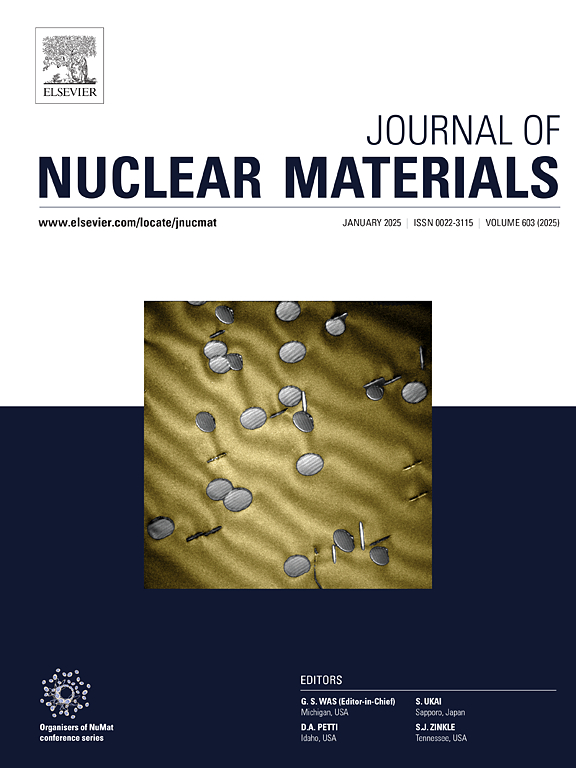UN(001)表面H2O2吸附和解离的第一性原理研究:温度和压力的热力学效应
IF 3.2
2区 工程技术
Q3 MATERIALS SCIENCE, MULTIDISCIPLINARY
引用次数: 0
摘要
作为高辐射领域的关键产物,UN与H2O2的相互作用对于理解UN作为耐事故燃料(ATF)的腐蚀和稳定性起着至关重要的作用。在本研究中,我们利用DFT + U和从头算原子热力学模拟研究了H2O2在UN(001)表面的吸附和解离行为。在不同的温度和压力条件下,研究人员分析了1 - 9个H2O2分子的吸附构型,从而深入了解与高辐射环境相关的表面反应。结果表明,H和O原子最稳定的吸附位是空心位,而OH基团更倾向于u顶位。对于单个H2O2分子,最稳定的分子解离、部分解离和完全解离的吸附能分别为-7.18 eV、-7.07 eV和-6.89 eV。自发分解(H2O2→2OH)发生,其中一个OH基团解离成O和H原子需要1.74 eV的显著能垒,随后进一步解离成O和H原子需要0.50 eV的较小能垒。增加H2O2覆盖促进分解成H2O和O原子。此外,H2O2吸附的稳定性受温度和压力的强烈影响,温度越高,覆盖面积越小,压力越高,吸附结构越稳定。这些发现为了解UN在核反应堆相关环境中的行为提供了重要见解,有助于开发更稳定和耐腐蚀的ATF材料。本文章由计算机程序翻译,如有差异,请以英文原文为准。
First-principles investigation of H2O2 adsorption and dissociation on the UN (001) surface: thermodynamic effects of temperature and pressure
The interaction between UN and H2O2, a key product in high radiation fields, plays a crucial role in understanding the corrosion and stability of UN as an accident-tolerant fuel (ATF). In this study, we investigated the adsorption and dissociation behavior of H2O2 on the UN (001) surface using DFT + U and ab initio atomic thermodynamic simulations. The adsorption configurations for one to nine H2O2 molecules were analyzed under varying temperature and pressure conditions, providing insight into surface reactions relevant to high-radiation environments. Results show that the most stable adsorption sites for H and O atoms are hollow sites, while OH groups favor U-top sites. For a single H2O2 molecule, the adsorption energies for the most stable molecular, partially and fully dissociative states are -7.18 eV, -7.07 eV and -6.89 eV, respectively. Spontaneous decomposition (H2O2→2OH) occurs, with one of the OH groups to dissociate into O and H atoms requiring a significant energy barrier of 1.74 eV, followed by further dissociation into O and H atoms with a smaller barrier of 0.50 eV. Increasing H2O2 coverage promotes dissociation into H2O and O atoms. Additionally, the stability of H2O2 adsorption is strongly influenced by temperature and pressure, with higher temperatures leading to lower coverages and higher pressures favoring more stable adsorption configurations. These findings provide important insights into the behavior of UN in environments relevant to nuclear reactors, contributing to the development of more stable and corrosion-resistant ATF materials.
求助全文
通过发布文献求助,成功后即可免费获取论文全文。
去求助
来源期刊

Journal of Nuclear Materials
工程技术-材料科学:综合
CiteScore
5.70
自引率
25.80%
发文量
601
审稿时长
63 days
期刊介绍:
The Journal of Nuclear Materials publishes high quality papers in materials research for nuclear applications, primarily fission reactors, fusion reactors, and similar environments including radiation areas of charged particle accelerators. Both original research and critical review papers covering experimental, theoretical, and computational aspects of either fundamental or applied nature are welcome.
The breadth of the field is such that a wide range of processes and properties in the field of materials science and engineering is of interest to the readership, spanning atom-scale processes, microstructures, thermodynamics, mechanical properties, physical properties, and corrosion, for example.
Topics covered by JNM
Fission reactor materials, including fuels, cladding, core structures, pressure vessels, coolant interactions with materials, moderator and control components, fission product behavior.
Materials aspects of the entire fuel cycle.
Materials aspects of the actinides and their compounds.
Performance of nuclear waste materials; materials aspects of the immobilization of wastes.
Fusion reactor materials, including first walls, blankets, insulators and magnets.
Neutron and charged particle radiation effects in materials, including defects, transmutations, microstructures, phase changes and macroscopic properties.
Interaction of plasmas, ion beams, electron beams and electromagnetic radiation with materials relevant to nuclear systems.
 求助内容:
求助内容: 应助结果提醒方式:
应助结果提醒方式:


